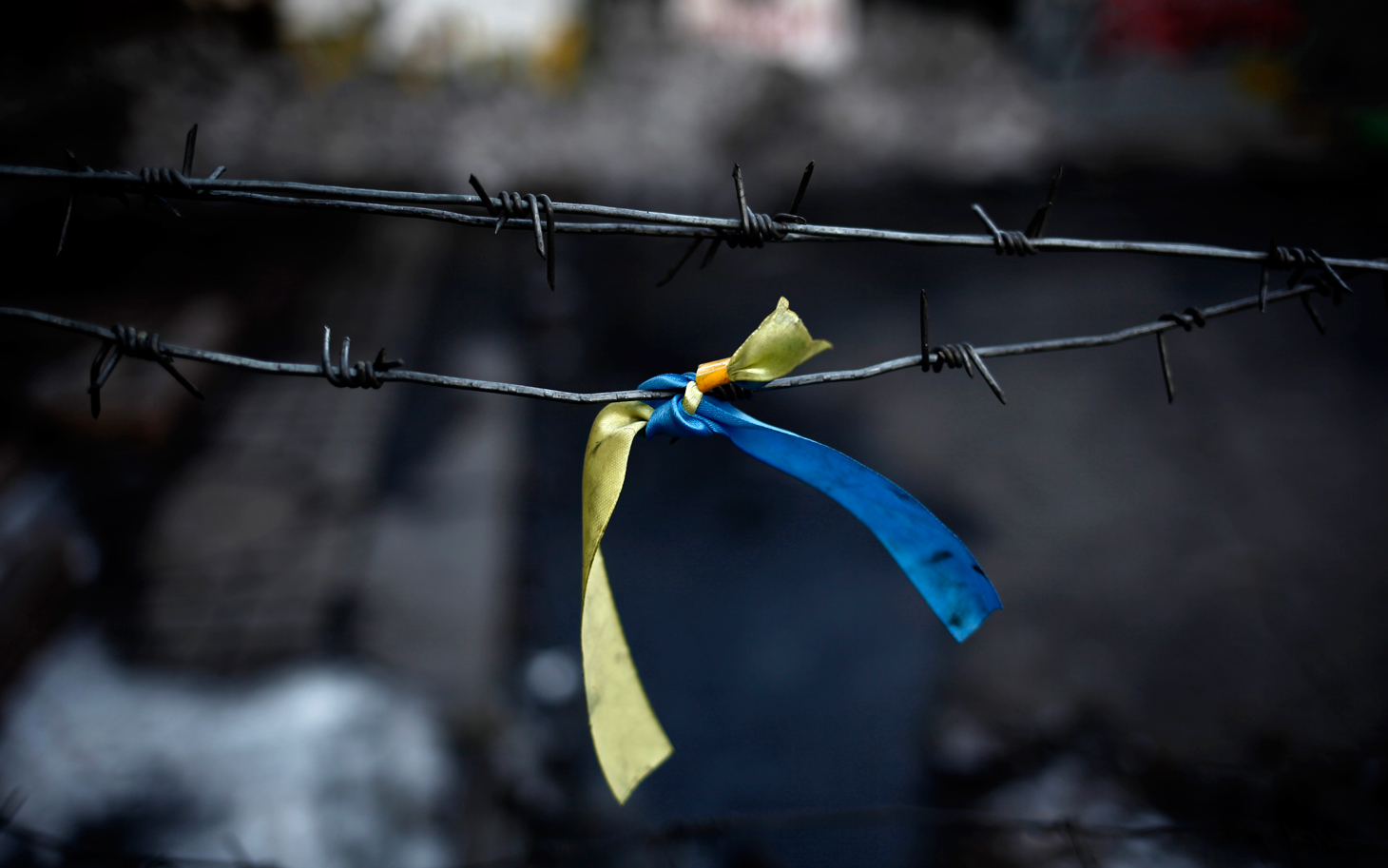
Ukraine Caught in the Straitjacket of Negotiating Formats
Publication: Eurasia Daily Monitor Volume: 12 Issue: 35
By:

The political and military terms of the Minsk Two agreement (February 12) and capture of Debaltseve by Russia’s proxies breaching the ceasefire (February 18) show the extent of Ukraine’s entrapment into Russia’s conflict stratagems. Russia has set those traps; the existing international system shows no way out for Ukraine; while some international actors even seem anxious to sidetrack the whole problem into those dead ends (see below).
Under the Minsk Two agreement, Ukraine is supposed to re-write its constitution by negotiating with the Donetsk-Luhansk “republics” (and duly considering Moscow’s inputs). In return for this, Ukraine would avoid an outright secession of those territories. Even short of secession de jure, however, Minsk Two allows those “republics” to maintain full-scale armed forces and control “their” sections of the Ukraine-Russia border, perpetuating Ukraine’s vulnerability (see EDM, February 13, 19, 20).
The Minsk armistice exposes Ukraine to continuing risks of losing territory. Russian and proxy forces moved the Minsk One demarcation line (September 2014) somewhat farther inside Ukraine by January 2015; farther still, seizing the Debaltseve area in February; and they look poised to move against Mariupol now (their actual plan is unclear, but the capability is in place and alarming). Following each Minsk agreement, Russia has re-started hostilities, taking another slice of Ukrainian territory and imposing more onerous political terms. Russian and Ukrainian commentators speculate about a Minsk Three, in continuation of those salami tactics.
Ukraine’s military situation has become even more complicated in the aftermath of Minsk Two. That agreement requires a pullback of missile systems and heavy artillery to certain distances on either side of re-configured demarcation lines (incorporating the Donetsk-Luhansk territorial gains). However, the agreement implicitly allows Donetsk-Luhansk troops (some of which may well be Russia’s military units) to forward-deploy in newly captured territory, with their far superior Russian-supplied tank forces.
The new armistice agreement does not restrict the deployment of tanks there. All this works to the Ukrainians’ disadvantage. Kyiv takes the position that it cannot pull back its missiles and artillery (the only remaining deterrent) without a reliable and durable ceasefire. Otherwise, further Debaltseve-type situations could recur. The Russian side, however, looks set to make the case that Kyiv violates the armistice by delaying the heavy artillery pullback (Sprotyv.info, February 22–25).
In this theater of conflict, Russia alone has the power to police ceasefires, “enforce” them against one side, protect the real ceasefire violators, and retain a nearly-discretionary freedom of action for Russia itself. Ukraine is outgunned in the field, outmaneuvered diplomatically, and quasi-isolated in the existing conflict-management bodies. These are the Contact Group (Ukraine, OSCE, Russia, Donetsk, Luhansk) and Joint Center for Control and Coordination (JCC, a bilateral Russian-Ukrainian military body), both under Russia’s sway in the West’s absence).
Using its veto rights, Russia has disabled the Organization for Security and Cooperation in Europe’s (OSCE) Special Monitoring Mission in Ukraine from monitoring the situation (let alone upholding Ukraine’s territorial integrity under the Helsinki Final Act, of which the OSCE is the custodian). Acknowledging the organization’s inadequacy in Ukraine, as in the other conflicts in the OSCE’s portfolio, Secretary-General Lamberto Zannier told Ukrainians: “For many years, we have dealt with similar situations in Transnistria, South Ossetia, Abkhazia, Karabakh. Transforming such conflicts into protracted political situations is not necessarily the worst scenario, considering the options we see now in eastern Ukraine. It is up to political leaders to find a way out” (Deutsche Welle, February 8; UNIAN, February 9).
Russian leaders may toy with Transnistria or Abkhazia scenarios in Ukraine’s east, but Ukrainian leaders want to escape such OSCE-approved outcomes. Ukraine, however, cannot count on meaningful security assistance from the United States or the North Atlantic Treaty Organization (NATO). At the United Nations Security Council on February 17, the Obama administration quickly approved the Russian-proposed resolution that enshrines and legitimizes the Minsk Two agreement (thus also the political terms that Russia deems binding on Ukraine). Russian President Vladimir Putin has expressed his full satisfaction, but no gratitude for this resolution’s expeditious shepherding (TASS, February 23; see EDM, February 23).
Marking the first anniversary of the regime-change on Kyiv’s Maidan, (Ukrinform, February 18-22), President Petro Poroshenko and Ukrainian Security Service (SBU) chief Valentyn Nalyvaichenko accused Vladislav Surkov, deputy head of Russia’s presidential administration, of involvement in coordinating the deadly crackdown on Maidan demonstrators. During 2014, nevertheless, Surkov was known to have become the Russian terminus of a Kyiv-Kremlin backchannel. Kyiv’s denunciation of Surkov signifies (or confirms) this channel’s closure. Kyiv had few options all along, and felt constrained to try that backchannel; but this option was clearly the worst.
Russian and proxy forces captured Debaltseve and five nearby localities from Ukraine on February 18. Germany and France, presumed guarantors of the ceasefire, were informed of Putin’s plan, but were unable to prevent the breach and proved unwilling to criticize Russia in the February 24 “Normandy” ministerial meeting.
With trust in the Normandy process at an all-time low, Kyiv turned to the United Nations and the European Union, asking them to consider authorizing a peacekeeping contingent or police mission in Ukraine. Hastily improvised, and born of despair, Kyiv’s request was turned down by the same Normandy trio as well as the European Commission (Ukrinform, February 18–25). Kyiv is consigned to the old OSCE Contact Group box; and the Normandy group understands its role as keeping Kyiv in that box.
As a cumulative result of these circumstances, Ukraine has been forced to retreat step by step from the supposedly agreed demarcation lines. Militarily, Ukraine faces Russia one on one. Diplomatically, Ukraine faces a Russo-German-French consensus that produced the Minsk Two agreement in the Normandy format. Those three powers differ over details, but have worked out a common political approach at this stage.
Further setbacks in the east could destabilize Ukraine’s politics and government and derail its reform efforts. Minsk Two, moreover, envisages recognition of Donetsk-Luhansk de facto, and re-negotiating Ukraine’s constitution with them. This issue, if taken on board in Kyiv, could split or topple the state leadership. The current Ukrainian leadership will not easily cave in, if at all. That could prompt another Russian military operation, capped by a yet more onerous Minsk Three (see above) to “implement” Minsk Two. All these scenarios undoubtedly enter into Russia’s calculations. As President Putin insinuates, “A Minsk Three is not necessary yet” (Rossiya 1 Television, February 23).




